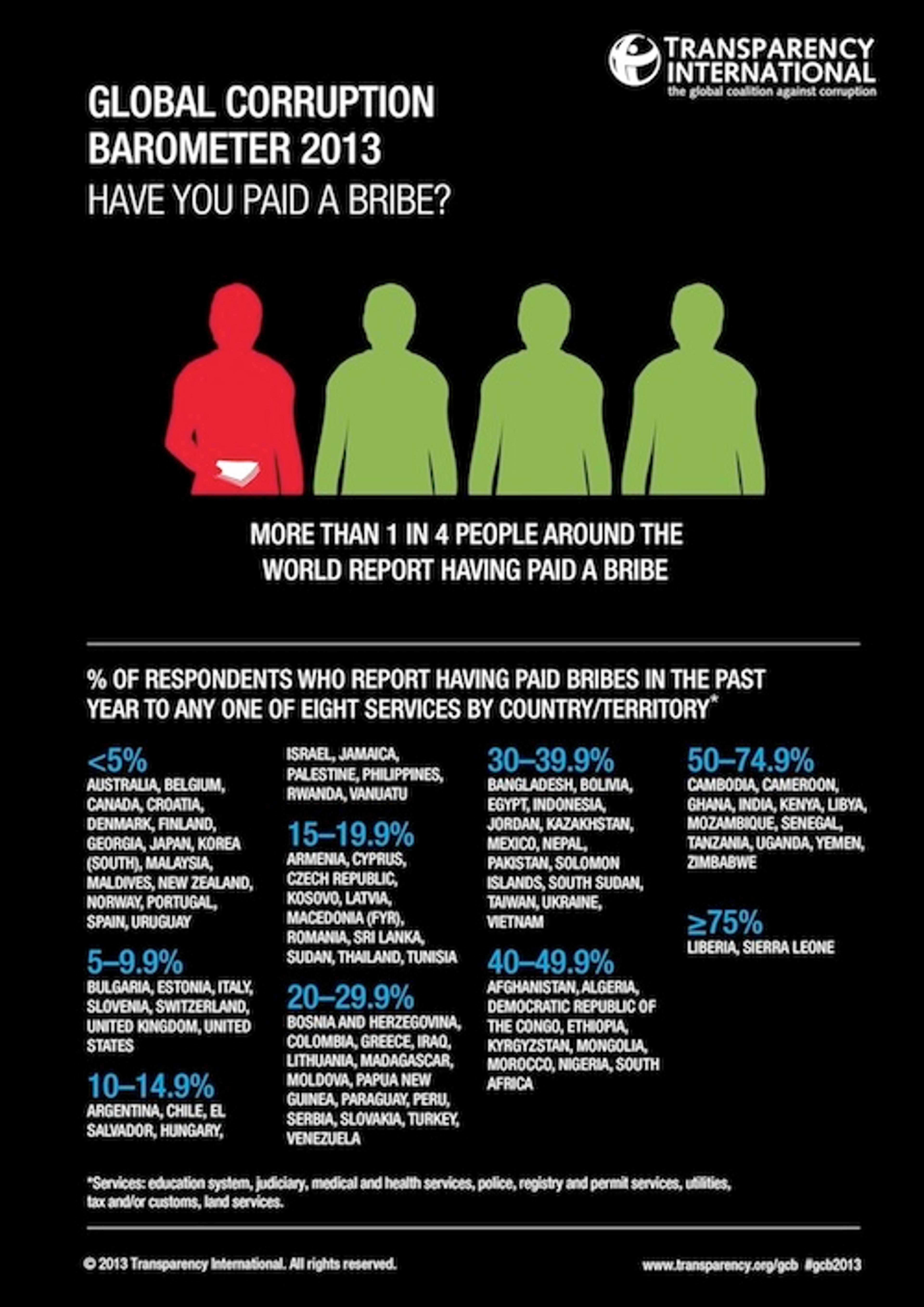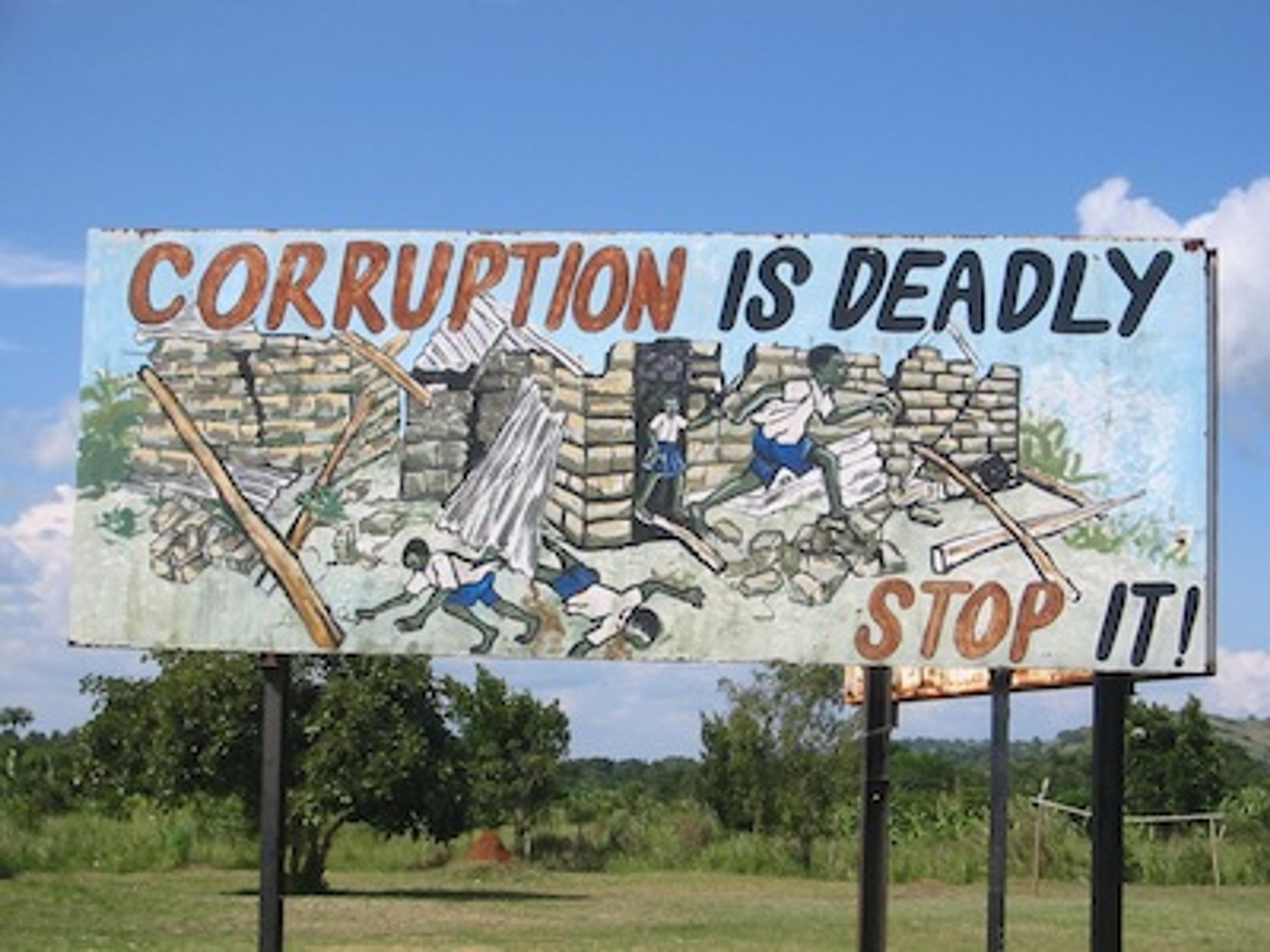Corruption exists in developing countries. Transparency International’s 2013 Global Corruption Barometer indicates that in a list of 23 countries, including those among the world’s poorest such as the Democratic Republic of the Congo and Ethiopia, almost every second person reported paying a bribe for a public service. In two of these, Sierra Leone and Liberia, this figure was over 75%, while individual high profile cases are never far from the headlines.
This gives rise to justifiable concerns when donating to charities working in developing countries where reported corruption is high, and governance and institutions are weak. Won’t our money, or the goods it buys, just be stolen? Faced with this challenge, how should a prospective donor respond?
Corruption is common in many countries across the world. Source: Transparency International Global Corruption Barometer 2013

First, what do we mean by corruption, and why don’t we like it? Here I’m not referring to ‘grand corruption’, large-scale looting by those taking advantage of their position in public office (e.g. Suharto, Marcos, Mobutu and others); what’s most relevant for Giving What We Can is ‘petty corruption’ in the form of theft of inputs or money designated for improving the lives of the poor by individuals or organisations.
This is clearly a bad thing: the poorest are totally deprived of the benefits of an intervention, and the donation that funds it is wasted. This sort of graft can also undermine confidence in the organisation concerned, and, on a macro level, the “psyche and moral fiber” of local society, according to some.
Corruption deprives the poorest of the benefits of an intervention. Credit: futureatlas.com

One response might be to avoiding donating altogether, which certainly ensures zero corruption in the use of your donations. But it also ensures zero impact; ideally we want to find some way of giving responsibly and still contributing to the alleviation of poverty.
Alternatively, you might demand a ‘zero tolerance’ approach to corruption from organisations you support. In fact, this has been the attitude of World Bank president Jim Kim, who in December 2013 declared corruption to be “public enemy number one,” adding, “we will never tolerate corruption, and I pledge to do all in our power to build upon our strong fight against it.”
Certainly, from a practical point of view, it’s a good idea to ensure that the charity you are giving to is aware of the risks of theft and corruption and has processes in place to avoid them. For example, the Against Malaria Foundation has a detailed risk register and places a high priority on ensuring nets are indeed distributed to beneficiaries through rigorous receipt mechanisms, data reporting post-distribution and independent monitoring. It also claims to work only with reputable distribution partners.
Likewise, the Schistosomiasis Control Initiative ensures that all transfers are checked and accounted for against a budget agreed jointly with the local Ministry of Health, regularly commissions audits of country programmes, and establishes close partnerships with those with whom they work in country (as well as having the advantage of distributing a drug with little to no market value). These sorts of procedures, in line with MANGO’s guide to financial management for NGOs, can help to give a donor confidence in the integrity of a charity’s operations.
However extending this to a ‘zero tolerance’ attitude is misguided for a number of reasons.
First, because you can never be certain of eliminating corruption. If corruption is actually an unfortunate fact of life in all societies to a certain extent (witness ample examples of corruption in ‘developed’ countries like the UK, such as LIBOR, and in Europe, where the cost of corruption may be up to £99bn), then it is fruitless to try to avoid it entirely.
To paraphrase William Savedoff in a blog post for the Center for Global Development, corruption is not going away anytime soon. In this context, a genuine ‘zero tolerance’ attitude is impractical: the standards would be so high as to render any work on the ground impossible.
Second, formal corruption controls have had limited success historically according to the evidence. It makes sense: if, as Nancy Birdsall of the Center for Global Development (whose argument is about public sector corruption but is still relevant for our purposes) you recognise that corruption is “almost always a symptom of a broader problem of weak systems of control, entrenched patronage, insider rents and privileges,” then it follows that stringent formal reporting requirements imposed from outside aren’t likely to be totally successful in avoiding the problem.
Third, a single-minded focus on corruption potentially overstates the threat it poses, and is itself a waste of resources. Above I mentioned that corruption is present in all societies. But that does not mean it is always present: because corruption stories in nonprofits make a good story, they often garner disproportionate press attention, giving the false sense that all charities inevitably suffer immense losses from corruption.
Savedoff discusses this very problem, arguing that, given our ignorance of how representative corruption cases are, stories of corruption in aid organisations are more likely to reflect better reporting of allegations than an actual greater fraud or corruption risk. Likewise but more generally, Olken and Pande, in their 2012 paper, find that “estimated levels of corruption are remarkably heterogeneous [in low-income countries]”.
Given this uncertainty, Professor Alan Fenwick, director of the Schistosomiasis Control Initiative, sees “prejudices and fears of corruption and wastage” as a distraction and obstacle to SCI’s work. Corruption is a key concern when working in certain societies, but some organisations may find it less of a problem than others. Witness the Against Malaria Foundation, which, fortunately, has experienced no material loss of nets through theft”.
This leads to an alternative point of view: as Savedoff points out, ‘how much money is wasted?’ might not even be the right question when we think about aid interventions. Rather, if our aim is to improve school attendance through deworming, for example, the first question should be ‘does the money that gets through have the desired impact?’ This chimes with the increasing interest in cash-on delivery and payment by results approaches to aid in larger-scale bilateral programs, where payment is made by funders to a recipient government or organisation only after there has been confirmed progress towards an agreed-upon goal.
Translating this philosophy to charitable giving at the individual level, it means we should look at the good done by an organisation as the principal measure of whether we should support them. This also has the advantage of working to minimise corruption in practice; if we make our donations conditional on an organisation’s achieving certain outcomes, then there is less scope for diverting money away from beneficiaries as this will result in reduced achievement of these outcomes. In essence, minimising corruption follows on from an emphasis on results.
Recognising that, when donating to charities, effectiveness comes first is not to say corruption should not also be tackled head on separately. And here, it is to developed country governments and companies that we must direct our attention. Global Financial Integrity (GFI) finds that for each $1 developing nations receive in foreign aid, $7 in illicit money flows abroad, depriving millions of public services. GFI research suggests, further, that about 45% of illicit flows end up in offshore financial centres, and 55% in developed countries, demonstrating rich countries’ complicity in this. No matter how much effort is put into making aid as effective as possible, without simultaneously addressing this crippling outflow of resources the net effect of rich countries on poor countries will continue to be negative. For those concerned about corruption, then, organisations working to combat it through increased financial transparency like Global Financial Integrity, Tax Justice Network, and Transparency International are good places to start informing yourself.
Each year a huge amount of money flows out of developing countries illegally. Credit: Global Financial Integrity

Returning, then, to the issue of corruption and charitable giving, what can we conclude? When faced with corruption, still give, but give smarter: seek out those organisations with credible mechanisms in place to avoid corruption, and, more importantly, which can demonstrate the biggest ‘bang for the buck’ – which are most effective at alleviating poverty according to rigorous evidence, such as the charities Giving What We Can recommends. Meanwhile for those who are particularly concerned about corruption, a promising start to an intervention is investigating illicit outflows from developing countries.